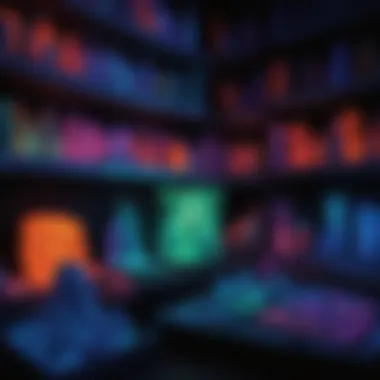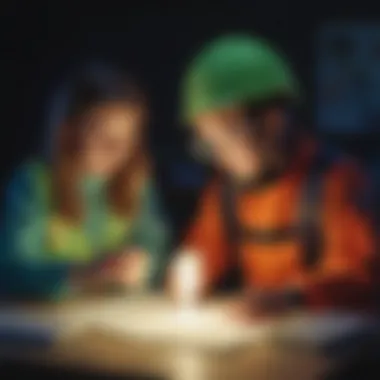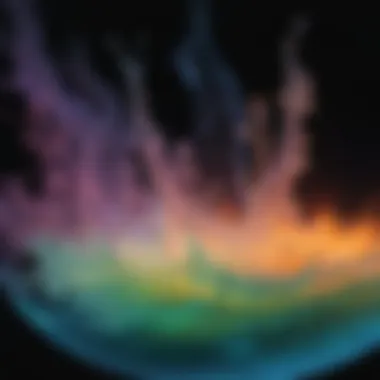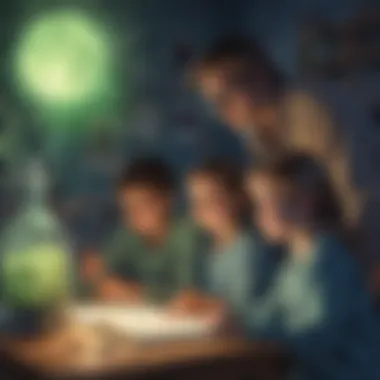Exploring Glow in the Dark Experiments: A Journey into Luminescence


Intro
In the realm of science, exploring luminescence presents a fascinating journey, especially for young minds brimming with curiosity. Glow in the dark experiments provide an engaging way to learn about basic scientific principles. Both parents and educators can use these experiments to foster critical thinking and a love for science among children aged 6-12. This guide will delve into the fundamental aspects of luminescence, the innovative methods to conduct experiments, and the importance of safety and sustainability.
Science Fun Facts
When embarking on this luminous adventure, interesting trivia can capture the young scientist's attention.
- What is luminescence? This refers to the emission of light by a substance not resulting from heat; thus, it's a cold light. For example, fireflies display a natural form of luminescence.
- Phosphors: These are materials that can store, absorb, and re-emit light. They play a vital role in the glow-in-the-dark aspect, captivating kids since the process is visual and interactive.
- Applications of Glow: Glow-in-the-dark substances are not just for fun; they also find their place in safety signs and sports equipment.
“Every glow comes with a reaction. Understanding the science behind it leads to better applications.”
Discover the Wonders of Science
To maximize learning outcomes in glow in the dark experiments, a variety of resources are available.
- Scientific Concepts: From photoluminescence to phosphorescence, it is beneficial to understand the underlying processes.
- Educational Videos: Sources like YouTube have visual content demonstrating these scientific reactions effectively.
- Interactive Tools: Online platforms offer simulations that allow children to experiment digitally before actual trials.
- Real-Life Applications: Learning how these phenomena work encourages young minds to identify applications in everyday life.
Science Experiment Showcase
Offering hands-on learning experiences is essential for deep understanding. Below are engaging experiments suited for the target audience:
Fun and Engaging Experiments
- Glow-in-the-Dark Slime: A popular choice that combines fun with experimentation. Glowing slime helps children see the transition of materials.
- Glow Jar: By using glow paint and jars, kids can create storage that shines at night, applying what they learn practically.
Step-by-Step Instructions
i. For slime, mix equal parts of white school glue and water; add glow powder from any trusted craft store.
ii. Stir and knead till the desired glow is achieved. Let the magical reaction unfold.
Materials List
- White school glue
- Water
- Glow powder or paint
- Cleaning supplies for any mess
Safety Tips and Precautions
- Always ask for adult supervision when necessary.
- Avoid ingestion of materials and unlikely reactions by ensuring safe age-appropriate practices.
Finale
By exploring glow in the dark experiments, children gain more than knowledge about luminescence. It nurtures curiosity and common sense in conducting science experiments. The comprehensive guide seeks to highlight safe and engaging methods to implement these fascinating phenomena into classrooms or at home.
Through practical activities, readers can embrace science as a rewarding domain full of mysteries.
Understanding Luminescence
Luminescence is a captivating phenomenon intriguing both young and adult science enthusiasts. Understanding this topic forms the backbone of glow-in-the-dark experiments, which combines elements of fun, learning, and discovery. Exploring luminescence opens the door to several scientific principles, allowing participants to comprehend hidden elements of daily life.
Understanding luminescence also fosters critical thinking and encourages inquiry. It helps clarify how certain materials emit light without heat, a contrast to typical lighting. Engaging with luminescence broadens perspectives and ignites curiosity, especially among kids.
What is Luminescence?
Luminescence refers to the emission of light by a substance not resulting from heat. Unlike incandescence, which involves thermal emission of light, luminescence holds a subtler yet fascinating charm. It can occur in a variety of scenarios around us, from the gleaming lights of fireflies to specialized luminescent materials.
Such light emission can be initiated by different energies, creating diverse experiences in the realm of science. This process operates at a molecular level, intriguing budding scientists eager to dive into hands-on experiments.
Types of Luminescence
Luminescence encompasses various forms, each with distinctive characteristics. The following sections highlight four primary types and their significance in glow-in-the-dark experiments.
Bioluminescence


Bioluminescence is light produced by living organisms, often found in species like fireflies and deep-sea fish. Its main characteristic lies in its biological origin. This feature makes bioluminescence exceptionally engaging in experiments. Kids become interested when connecting luminescence to life itself.
One benefit of bioluminescence for experiments is its naturally occurring light, promoting lessons in biology. Effectively exploring its mechanisms encourages biological and environmental awareness among young minds. A common disadvantage is its limited versatility when compared to synthetic alternatives.
Chemiluminescence
Chemiluminescence occurs when chemical reactions release energy in the form of light. This type, often described as creating instant brightness, highlights chemistry's role in luminosity. It's popular in experiments like glow sticks, where an easy reaction involves mixing two components.
Key benefits of chemiluminescence include simplicity and accessibility for young science learners. It's an excellent entry point for engaging children in chemistry. However, the relatively short duration of light can be a drawback, limiting extended experiences.
Fluorescence
Fluorescence is a process in which a substance absorbs light of specific wavelengths and re-emits it almost instantaneously. This phenomenon benefits practical experiments, as it reveals an instant and visually clear outcome. Common occurrences include fluorescent markers and specific minerals.
Fluorescence offers remarkable clarity during experiments, bridging the gap between science and observation. Yet, its downside might be the necessity for a UV light source, which is not always readily available in simple setups.
Phosphorescence
Phosphorescence differs from fluorescence by storing absorbed energy over time for gradual release. This creates a glow-in-the-dark effect visible even after the light source turns off. It is frequently used in toys and safety signs.
Key characteristics include its prolonged luminescence. Students learn about energy conservation principles during phosphorescence experiments, leading to deep or more thoughtful inquiry. The challenge of charging these materials optimally stands as a downside for younger audiences.
Applications of Luminescent Materials
The applications of luminescent materials span various fields ranging from safety to entertainment. These materials find uses in glow-in-the-dark products, such as paints and crafts. Understanding these applications solidifies the importance of luminescent experiments for practical science education.
Even visuals from glow-in-the-dark stars can teach spatial awareness in children. Emerging ideas on sustainability pave the path for responsible experimentation and enlighten kids about ecological responsibilities.
Overall, comprehending luminescence lays the groundwork for practical, hands-on experiments that blend science while igniting imagination and discovery.
Materials for Glow in the Dark Experiments
Materials are the backbone of any experiment, particularly those focused on luminescence. Understanding the specific materials used in glow in the dark experiments is essential for achieving desired outcomes. The right materials enable successful creation and understanding of luminescent phenomena. Moreover, familiarity with these materials can enhance safety and sustainability practices.
Common Luminescent Materials
Zinc Sulfide
Zinc Sulfide is a widely used luminescent material, notably known for its ability to emit light after being excited by an external energy source such as ultraviolet light. This mineral has a key characteristic that makes it significant in glow-in-the-dark applications—it requires less energy than others to achieve luminescence.
This property renders Zinc Sulfide as a valuable choice for educational purposes. It is easy to obtain and can produce bright green or blue hues depending on how it is processed. Although these characteristics are favorable, there are disadvantages. Zinc Sulfide has a phenomenon known as “diminishing glow”, where its brightness declines rapidly once the excitation source is removed. Its relatively short glittering time might limit some experiments but it remains broadly used due to its affordability and availability.
Strontium Aluminate
Strontium Aluminate is another prominent luminescent material, notable for its prolonged afterglow—sometimes lasting for hours. This compound stands out due to its remarkably bright glow among other luminescent materials. Its reactivity with different energy sources leads to various applications ranging from decorations to safety signs. Strontium Aluminate shows superior brightness compared to Zinc Sulfide, making it a preferred choice for projects that require a longer-lasting effect.
However, obtaining Strontium Aluminate might be more difficult depending on the location and market availability. Though more effective in terms of long-term brightness, it might require more energy to reach optimal luminescent properties, which some experimenters could find challenging.
Glow in the Dark Paints
Glow in the Dark Paints consist of various luminescent materials blended with binding agents to create easy application layers on surfaces. These paints can harness pigments like Zinc Sulfide or Strontium Aluminate, making them versatile for several applications including artistic endeavors and educational experiments. The most significant feature of these paints is their ease of use. They can be painted onto various items, providing a family-friendly introduction to luminescence.
Nonetheless, there are concerns surrounding durability and adherence of such paints on certain surfaces. Considering the varying light exposure, glow-in-the-dark paints may also show weaker luminosity compared to crystals or powders used in experiments. Understanding these factors is crucial for anyone looking to use them effectively in glow in the dark experiments.
Safety Considerations
While engaging in glow in the dark experiments, it is critical to prioritize safety. Many luminescent materials are safe, but obtaining from reliable sources ensures safety from contaminants. Protective equipment such as gloves and safety goggles is essential when handling certain raw materials.
Sustainability of Glow in the Dark Materials
Lastly, conversation around sustainability comes into focus when selecting materials. Many glow-in-the-dark products undergo implications within their life cycle. It’s important to consider greener options like non-toxic glow paints and to ensure proper disposal methods for luminescent materials.
Understanding materials, safety, and sustainability enhances the educational value of glow in the dark experiments.


Setting Up Glow in the Dark Experiments
Setting up glow in the dark experiments is a foundational aspect of engaging young minds in luminescence. Understanding how to properly prepare for these experiments ensures they are safe and educational. In this section, we will explore the steps necessary to effectively set up an experiment, how to choose appropriate activities, and the importance of safety in creating an optimal learning environment.
Choosing the Right Experiment
When organizing a glow in the dark experiment, it is essential to select the right one based on both age and the interests of the participants. Not all experiments are equally engaging or appropriate for every age group. Activities should reflect a balance of simplicity and curiosity to keep young scientists enthused.
Factors to consider include:
- Complexity: Ensure the experiment matches the skill level or cognitive abilities of the children.
- Purpose: Pick experiments that can help explain different concepts of luminescence, enabling in-depth discussions that foster greater understanding.
- Materials available: Consider what supplies you have on hand or can easily procure before choosing an experiment.
By aligning the experimental choices with these factors, you can promote effective engagement and learning.
Gathering Supplies
Once the right experiment is chosen, it is crucial to gather the necessary supplies. The proper materials can significantly impact the success of the experiment and the learning experience.
Common supplies might include:
- Luminescent powders or paints, like zinc sulfide or strontium aluminate.
- Basic household items, such as cornstarch or white glue for slime.
- Other materials like glow sticks or baking soda for various chemical reactions.
Make a checklist of all essential supplies so you can avoid interruptions during the experiment. Additionally, if you optimally collect them well before starting, it provides the opportunity to engage children in preparation, enhancing their learning experience.
Creating a Safe Workspace
A safe workspace is vital when conducting glow in the dark experiments. If children are to handle materials or conduct experiments, the environment must be secure. That ensures both student energy and scientific curiosity can flourish without risk.
Ensure a designated area is clear, organized, and free from hazards. Focus on:
- Ventilation: Particularly for experiments that release fumes.
- Availability of protective gear: Things like goggles or gloves, depending on the materials used.
- Supervision: Constant adult presence to guide and support young learners.
Creating a well-prepared and protective environment dramatically enhances the experimental inflounce and inspires participants.
By attentively following these guidelines, both children and adults can appreciate a seamless venture into the fascinating world of glow in the dark experiments.
Fun Glow in the Dark Experiments
Fun glow in the dark experiments provide a unique experience for children to engage with the fundamental principles of science in a hands-on and captivating manner. By experimenting with luminescent materials, children improve their critical thinking skills. They learn to make observations, formulate hypotheses, and analyze results. Exploring luminescence also encourages teamwork and collaboration, fostering an active learning environment.
Understanding glow in the dark phenomena taps into children's natural curiosity. It opens a window to chemistry, physics, and biology, as many glow-in-the-dark materials have origins in these fields. Moreover, fun experiments spark discussion about the science underlying safe handling practices and sustainable materials.
Here are several engaging experiments to explore:
Experiment One: Glow in the Dark Slime
Glow in the dark slime is both fun and educational. Making slime allows children to understand polymer chemistry in an interactive way. The key materials include:
- Clear white glue
- Baking soda
- Glow powder or phosphorescent pigment
- Contact lens solution
To create the slime:
- In a bowl, mix 1/2 cup of clear glue with 1/2 teaspoon of baking soda.
- Stir in 2-3 tablespoons of glow powder.
- Slowly add contact lens solution until the mixture forms slime.
- Knead the slime until it reaches the desired texture.
This experiment helps children learn about non-Newtonian fluids and the properties of polymers. Make sure to follow safety guidelines when handling materials.
Experiment Two: Homemade Glow in the Dark Paint
Homemade glow in the dark paint can be made using non-toxic materials. This experiment emphasizes creativity while reinforcing scientific principles. Materials needed:
- Clear glue
- Water
- Glow in the dark pigment
- A mixing container
To prepare the paint:


- Combine equal parts of clear glue and water.
- Mix in the glow pigment thoroughly until well combined.
- Use the paint on paper or other surfaces.
Creativity thrives in this experiment. Children can see their artistic expressions come to life in the dark. Learning how different compositions affect luminescence helps deepen their understanding of mixing substances.
Experiment Three: Glow Sticks Chemistry
Glow sticks are a brilliant contestation of chemistry, showcasing light emission without heat. Here, students learn chemical reactions that produce light. The materials involved are whole glow sticks containing:
- Hydrogen peroxide
- Phenyl oxalate ester
- and a fluorescent dye
When bending a glow stick, the chambers mix and produce light.
This experiment can demonstrate basic principles of synthetic chemistry in a very tangible way. It offers opportunities for discussions about safety and environmental implications of disposing of glow sticks.
Experiment Four: Phosphorescent Crystals
Forming phosphorescent crystals combines art with science and allows examination of structural formation. The building blocks include:
- Sugar or borax
- Water
- A heat source
- To create the crystals, follow ont he steps:
- Heat solutions of sugar or borax until dissolved .
- Allow to crystallize by generating a saturated solution.
- Pour into a dish and observe crystals fortom over time.
Results may vary which aids nurture a sense of curiosity. The expansion on how these glow materials behave can lead to self-directed inquiry.
Experiment Five: Glow in the Dark Water
This experiment involves creating glow in the dark water and observing its luminescent qualities in different lighting conditions. To make glow in the dark water, gather:
- Clear container
- Glow in the dark powder
- Clean water
Procedure include:
- Add the glow powder to the water in a clear container.
- Stir until completely dissolved.
- Shine a light on the container to activate luminescence.
The simplicity lets young scientists observe varied glow patterns under low light conditions. Understanding experiential interactions with light and particles empowers a stronger grasp of scientific concepts.
Direct engagement with science shines for young minds. It builds creativity, critical skills, and problem-solving—crucial experiences in their path to education. Embracing fun blends learning with playfulness, setting a solid foundation for future exploration.
Analyzing Results
Analyzing the results of glow in the dark experiments is a necessary step in understanding and appreciating the science of luminescence. This section focuses on two main areas: observing glow patterns and documenting findings. Engaging in this analysis is beneficial for developing critical thinking skills. Additionally, it reinforces the scientific method, giving children the opportunity to make conclusions from their observations.
Observing Glow Patterns
Observing glow patterns is an exciting part of conducting glow in the dark experiments. When experimenting, one of the main objectives is to see how different materials react to light and observe how they emit luminescence. Understanding these patterns can lead to insights about the luminescent properties of different substances.
The following points can guide children as they observe:
- Brightness Levels: Note the intensity of the glow from the materials used. Are some materials brighter than others?
- Duration of Glow: Record how long the materials shine after exposure to light. How long does it take for each material to fade?
- Color Changes: Analyze any changes in color as the glow fades. Do certain substances glow different colors?
Creating a simple chart to log these observations can be beneficial. Over time, children can correlate their observations with the materials’ characteristics, cultivating a deeper understanding of luminosity within these materials.
Understanding glow patterns enrich international conversations about light sciences by fostering inquiry and interest in materials science.
Documenting Findings
Documenting findings serves as an important record of each experiment, offering insight into what worked, what did not, and why. Maintaining good documentation enhances the learning process and helps tracking progress over time. There are several factors to consider when writing up findings:
- Date and Details: Keep a record of when the experiment was conducted and key details such as materials used and methodology.
- Observations: Instead of just saying “it glowed,” encourage noted observations like “the glow faded slowly over three minutes.”
- Photos: Add photographs of the glow effects if possible. Visual proof solidifies observations facts.
- Reflections: Include what went well and what could be improved for the next experiment. This promotes continuous learning.
Using a science notebook or digital document for documentation stands out as an effective practice. Kids can return to this log, recognizing their growth in scientific understanding over time. Just like the glow of luminescent materials, their curiosity in science should remain vibrant and illuminating, guiding future experiments and explorations.
Further Exploration and Resources
Exploring glow in the dark experiments opens a door to understanding the fascinating world of luminescence. This section provides valuable resources to deepen your knowledge. Books, online platforms, and learning methods emphasize the importance of continuous discovery in science. These tools enable kids, parents, and educators to take further steps into this subject.
Books on Luminescence
Books dedicated to luminescence provide thorough insight. They combine scientific history with hands-on experimentation. Consider reading these authors and titles:
- **







